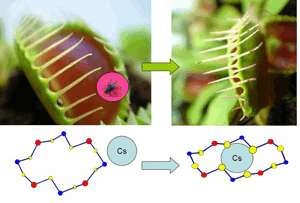Nuclear Shop of Horrors
Air Date: Week of March 12, 2010

(Image: Mercouri Kanatzidis, Courtesy Argonne National Laboratory)
Nuclear waste is extremely difficult to clean up. But, as Emily Guerin reports, a new synthetic material can snap up radioactive ions like a Venus fly-trap devours insects.
Transcript
[SCIENCE NOTE THEME]
GUERIN: Scientists have long taken inspiration from nature when designing products. Cars are streamlined like fish for better aerodynamics; swimsuits are made of imitation sharkskin to move efficiently through water. The newest copycat looks to the Venus flytrap to clean up nuclear waste. Researchers at Northwestern University have designed a synthetic material that will snap up radioactive cesium ions from nuclear waste, leaving harmless ions behind. This is no easy task: safe ions in the waste, such as sodium, outnumber cesium by a ratio of almost one thousand to one.

(Image: Mercouri Kanatzidis, Courtesy Argonne National Labrotory)
Here’s where the Venus flytrap idea comes in. The carnivorous plants are very sensitive and only clam up if multiple hairs on their leaves are touched. This allows the flytrap to distinguish between living prey and inanimate objects, like falling raindrops or debris. The researchers came up with a material made with sulfur ions to mimic the plant’s behavior. When the sulfur and cesium ions meet, the material’s pores close around the cesium, trapping it inside like an insect within a Venus flytrap.
Only cesium triggers the reaction – the material ignores sodium the same way the flytrap ignores rain drops. Scientists say more research is needed. But maybe some day nuclear power plants will send their waste to the radioactive equivalent of a Little Shop of Horrors, complete with a cesium-devouring plant named Audrey. That’s this week’s Note on Emerging Science. I’m Emily Guerin.
Links
Living on Earth wants to hear from you!
Living on Earth
62 Calef Highway, Suite 212
Lee, NH 03861
Telephone: 617-287-4121
E-mail: comments@loe.org
Newsletter [Click here]
Donate to Living on Earth!
Living on Earth is an independent media program and relies entirely on contributions from listeners and institutions supporting public service. Please donate now to preserve an independent environmental voice.
NewsletterLiving on Earth offers a weekly delivery of the show's rundown to your mailbox. Sign up for our newsletter today!
 Sailors For The Sea: Be the change you want to sea.
Sailors For The Sea: Be the change you want to sea.
 The Grantham Foundation for the Protection of the Environment: Committed to protecting and improving the health of the global environment.
The Grantham Foundation for the Protection of the Environment: Committed to protecting and improving the health of the global environment.
 Contribute to Living on Earth and receive, as our gift to you, an archival print of one of Mark Seth Lender's extraordinary wildlife photographs. Follow the link to see Mark's current collection of photographs.
Contribute to Living on Earth and receive, as our gift to you, an archival print of one of Mark Seth Lender's extraordinary wildlife photographs. Follow the link to see Mark's current collection of photographs.
 Buy a signed copy of Mark Seth Lender's book Smeagull the Seagull & support Living on Earth
Buy a signed copy of Mark Seth Lender's book Smeagull the Seagull & support Living on Earth

